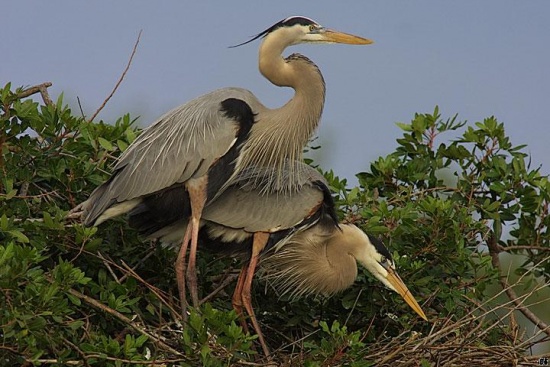- Ardea herodias
Identification
The largest heron in North America
Ht. 3-4 ft
W. 6ft
- Blue-gray feathers on most of its body
- Plume of feathers on its chest and back during breeding
- Long, pointed yellow bill
- Long legs
- Adults have white on the top of their heads and long black plumes above their eyes
- Juveniles have elongated spots and stripes on their neck and upper breast area
"Great White" Heron
There is also an all white version of the Great Blue Heron, the "Great White" Heron. The great white heron was originally described as a distinct species, but is currently considered to be the white morph of Great Blue Heron. The "Great White" differs from the the Great Blue in bill morphology, head plume length, and in having a total lack of pigment in its plumage. The form is found nearly exclusively in marine waters along the coast of S. Florida. It can be seen in other regions of Florida and the Caribbean although not common. It has yellow legs, a yellow bill and white feathers.
Where the dark and white forms overlap in Florida, intermediate birds known as "Wurdemann's Herons" can be found. It is very rare and confined to extreme southern Florida and the Florida Keys. The birds white head and blue blody form resembles a Great Blue Heron (Florida race) with a white upper neck and head and it lacks the black plumes of the nominate race.
Similar species
The risk of misidentification is greatest for the "Great White Heron" type, and here are some pointers for each of a number of possible mistakes:
- Great Egret has yellow bill but black legs (yellow legs in Great White Heron)
- Snowy Egrets have a black bill and black legs, both of which are wrong for this species (do look at juveniles that are less clear-cut) and the bill is finer and more pointed
- Cattle Egret would have a much smaller bill and shorter legs
- Juvenile Little Blue Heron or white morph Reddish Egret would not have a yellow bill or yellow on the legs.
Distribution
It is found throughout most of North America, including Alaska, Quebec and Nova Scotia. The range extends south through Florida, Mexico and the Caribbean to South America.
Very rare vagrant to the Azores and United Kingdom.
Migrates in the fall, although some stay in the northern part of their range.
Taxonomy
Five subspecies are recognized[1]:
- A.h. fannini - South-eastern Alaska to coastal Washington
- A.h. herodias - Southern Canada to southern Baja California and Central America
- A.h. wardi - South-central USA to Gulf Coast and Florida
- A.h. occidentalis - Southern Florida through West Indies to islands off Venezuela
- A.h. cognata - Galapagos Islands
Habitat
Margins of lakes and slow-flowing rivers, swamps and marshes, frequently on sea-coasts, in estuaries and mangroves.
Behaviour
Usually tucks its head into an S-shape when it is resting and flying.
Diet
Their main diet consists of fish.
References
- Clements, J. F., T. S. Schulenberg, M. J. Iliff, B.L. Sullivan, C. L. Wood, and D. Roberson. 2013. The eBird/Clements checklist of birds of the world: Version 6.8., with updates to August 2013. Downloaded from http://www.birds.cornell.edu/clementschecklist/download/
- Handbook of the Birds of the World Alive (retrieved July 2014)
- Thread in the id forum discussing the "Great White" form
Recommended Citation
- BirdForum Opus contributors. (2025) Great Blue Heron. In: BirdForum, the forum for wild birds and birding. Retrieved 15 January 2025 from https://www.birdforum.net/opus/Great_Blue_Heron
External Links






